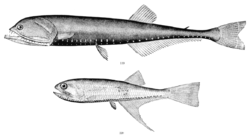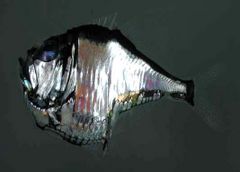Fish Guide
Stomiiformes
|
From Wikipedia the free encyclopedia, by MultiMedia |
| Stomiiformes | ||||||||
|---|---|---|---|---|---|---|---|---|

Elongated bristlemouth, Gonostoma elongatum
(top) and Bonapartia pedaliota (bottom)
|
||||||||
| Scientific classification | ||||||||
|
||||||||
|
Gonostomatoidei Phosichthyoidei See text for families. |
Stomiiformes is an order of deep-sea ray-finned fishes of very diverse morphology, including dragonfishes, lightfishes, marine hatchetfishes, viperfishes, and loosejaws. The order comprises four families, more than fifty genera and a total of about 320 species. As usual for benthic fishes, there is no common name for all the species comprised in this order.
The smallest species of this order is Cyclothone pygmaeae, native to the Mediterranean Sea (1.5 cm for adult specimens), while the largest one is Opostomias micripnis, widely found in the Atlantic, Indian and Pacific Ocean (50 cm for adults). Other species range from less than 2 cm to more than 50 cm in length.
Contents |
Distribution and morphology

Members of this order are mostly benthic fishes (living in deep oceanic waters), even if certain of them are also found in middle waters. Their distribution around the world's oceans is very wide, ranging from subtropical and temperate water bodies up to subartic or even antarctic ones.
These fish have a nightmarish and weird appearance. They all have teeth on the premaxilla and maxilla. Their maxillary ligaments, as well as some muscles and certain bones in the branchial cavity, are specialized in a distinctive way. Most have large mouths extending back past the eyes (Some also have chin barbels). Several fins might be absent, and colors are typically dark brown or black.
Luminescence

As is the usual case for abyssal sea creatures, all members of Stomiiformes but one have luminescent organs (photophores), whose structure is characteristic of the order. The gleam emitted can be more or less strong and its color can be light yellow, white, violet or red. The lighting mechanism can be very simple — consisting of small gleaming points on the fish body — or very elaborate, involving lenses and refractors.
The most common arrangement is one or two rows of photophores on the lower part of each side of the body. The rows run from the head down to the tip of the tail. Photophores are also present at the tip of chin barbels. Stomiiforms do not seem to utilize bacteria as their lighting source: no bacterium has ever been found in their photophores. However, recent researches have found that a piece of bacterium-like DNA in one photophore, which suggests that these contain bacteria that must have been largely modified.
The light coming from these fish is generally invisible to their prey.
Daily migration
During the day, Stomiiformes fish stay in deep waters and measure the intensity of the light that reaches them. By doing so, they manage to stay in the region that always has the same light intensity. When the sun sets, the fish follows the dimming sunlight up to near-surface waters. The upper regions are richer in animal life: small fishes, and planktonic invertebrates. The fish hunt and feed on these organisms all night long and swim back to deep waters as soon as the sun rises.
This daily migration is well observed at quite a few species of stomiiforms. However it is not specific to this fish order, and some larger species of the order — among them the largest predator of the oceans — stay in their deep-sea habitat and feed on smaller migrants that return from the surface.
Reproduction
Stomiiforms lay eggs generally in deep seas, but the eggs are light and float towards the ocean surface. They hatch in surface waters. When the larvae have completed their metamorphosis and look like adults, they descend to join the adults.
Like a lot of benthic fish species, certain members of the order — especially in the genera Gonostoma and Cyclothone — change their sex during their life. They are born being males, then transform into females.
Classification

There are four families in two suborders:
- Suborder
Gonostomatoidei
- Gonostomatidae — bristlemouths
Sternoptychidae — marine hatchetfishes
- Gonostomatidae — bristlemouths
- Suborder
Phosichthyoidei
- Phosichthyidae — lightfishes (spelled
Photichthyidae in J. S. Nelson)
Stomiidae — barbeled dragonfishes and loosejaws.
- Phosichthyidae — lightfishes (spelled
Photichthyidae in J. S. Nelson)
Primitive stomiiforms had thin brownish bodies, with rows of egg-shaped photophores adorning the lower body parts, and mouths with numerous teeth. From this primitive form two evolutive lineages diverged.
In the suborder Gonostomatoidei, the Gonostomatidae are primitive and the Sternoptychidae are more derived.
In the suborder Phosichthyoidei, the Phosichthyidae are also primitive bioluminescent organisms, while the Stomiidae are extremely derived and diverse.
References
- "Stomiiformes". FishBase. Ed. Ranier Froese and Daniel Pauly. January 2006 version. N.p.: FishBase, 2006.
- J. S. Nelson, Fishes of the World
Fish Guide, made by MultiMedia | Free content and software
This guide is licensed under the GNU Free Documentation License. It uses material from the Wikipedia.